AUDI A5 CABRIOLET 2017 Owners Manual
Manufacturer: AUDI, Model Year: 2017, Model line: A5 CABRIOLET, Model: AUDI A5 CABRIOLET 2017Pages: 266, PDF Size: 66.64 MB
Page 211 of 266
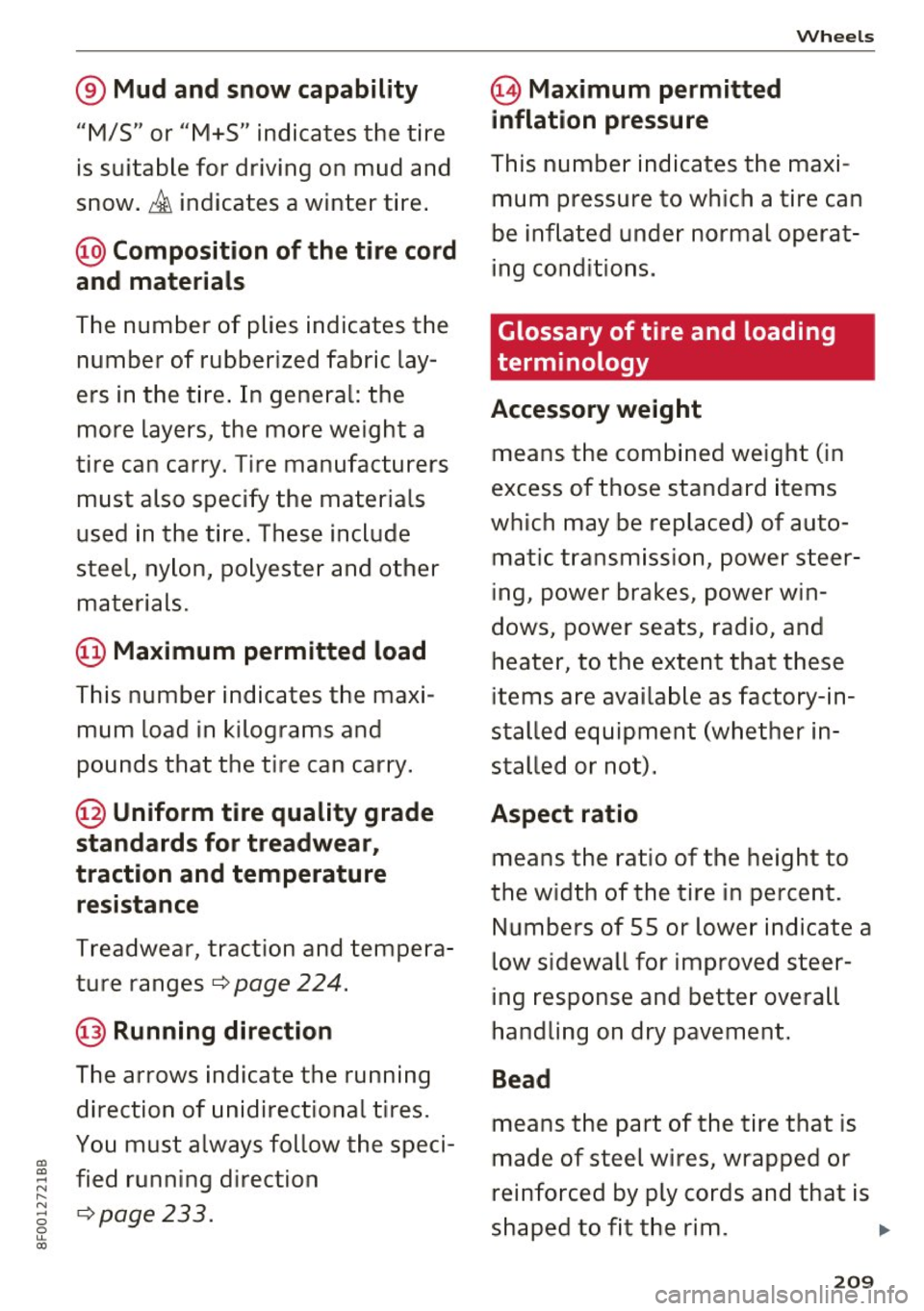
"' "' .... N ,.._ N .... 0
0
u. a:,
® Mud and snow capability
"M/5" or "M+S" indicates the tire
is suitable for driving on mud and
snow. £ indicates a winter tire.
@Composition of the tire cord
and materials
The number of plies indicates the
number of rubberized fabric lay
ers in the tire . In general: the
more layers, the more weight a
tire can carry. Tire manufacturers
must also specify the materials
used in the ti re . These inc lude
stee l, nylon, polyester and other
materials.
@ Maximum permitted load
This number indicates the maxi
mum load in kilograms and
pounds that the tire can carry.
@ Un iform tire quality grade
standards for treadwear,
traction and temperature resistance
Treadwear, traction and tempera
ture ranges
c:::> page 224.
@ Running direction
T he arrows indicate the running
direction of unidirectional tires.
You must always follow the speci
fied running direction
c:::>page 233 .
~ Maximum permitted
inflation pressure
Wheels
T his number indicates the maxi
mum pressure to which a tire can
be inflated under normal operat
ing condit ions .
Glossary of tire and loading
terminology
Accessory weight
means the combined weight (in
excess of those standard items
which may be replaced) of auto matic t ransmission, power steer
ing, power brakes, power win
dows , powe r seats, radio, and
heater, to the extent tha t these
items are avai lab le as factory- in
stalled equipment (whether in
s t alled or not).
Aspect ratio
means the ratio of the height to
the w idth of the tire in percent.
Numbers of 55 or lower indicate a
low sidewall for improved steer
ing response and better overall
handling on dry pavement .
Bead
means the part of the tire that is
made of steel wires, wrapped or
reinfo rced by ply cords and that is
shaped to fit the rim. ...
20 9
Page 212 of 266
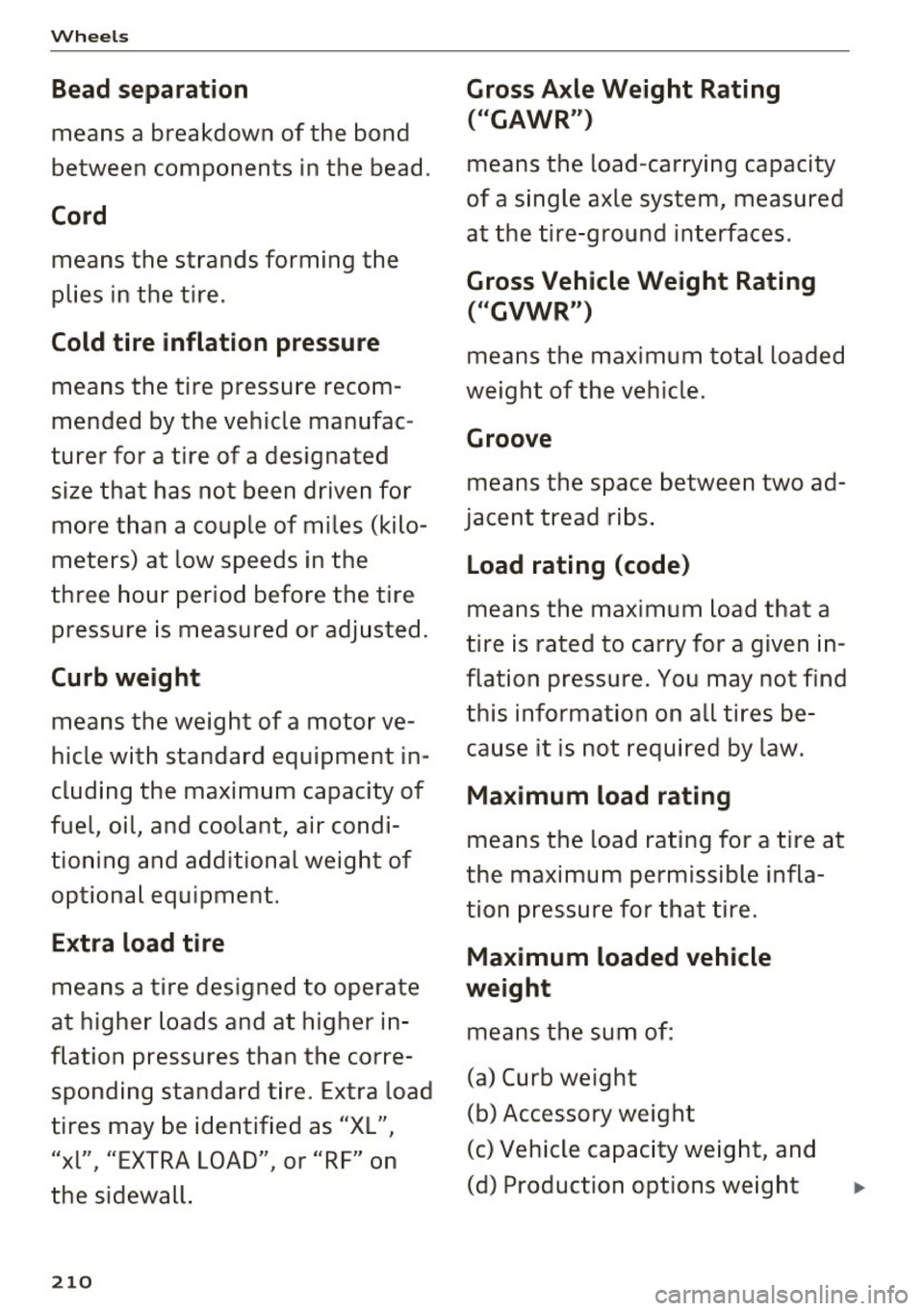
Wheel s
Bead separation
means a breakdown of the bond
between components in the bead .
Cord
means the strands forming the
plies in the tire.
Cold tire inflation pressure
means the tire pressure recom
mended by the vehicle manufac
turer for a tire of a designated
size that has not been driven for more than a couple of miles (kilo
meters) at low speeds in the
three hour period before the tire
pressure is measured or adjusted.
Curb weight
means the weight of a motor ve
hicle with standard equipment in
cluding the maximum capacity of
fuel, oil, and coolant, air condi
tioning and additional weight of
optional equipment.
E x tra load tire
means a tire designed to operate
at higher loads and at higher in
flation pressures than the corre sponding standard tire . Extra load
tires may be identified as "XL",
"xl", "EXTRA LOAD", or "RF" on
the sidewal l.
210
Gross Axle Weight Rating
("GAWR ")
means the load-carrying capacity
of a single axle system, measured
at the tire -ground interfaces .
Gross Vehicle Weight Rating
(" GVWR ")
means the maximum total loaded
weight of the vehicle .
Groove
means the space between two ad
jacent tread ribs .
Load rating (code )
means the maximum load that a
tire is rated to carry for a given in
flation pressure. You may not find
this information on all tires be
cause it is not required by law.
Ma ximum load rating
means the load rating for a tire at
the maximum permissible infla tion pressure for that tire.
Ma ximum loaded vehicle
weight
means the sum of :
(a) Curb weight
(b) Accessory weight
(c) Vehicle capacity weight, and
(d) Production options we ight
Page 213 of 266

"' "' .... N ,.._ N .... 0
0
u. a:,
Maximum (permissible )
inflat ion pressure
means the maximum cold infla
tion pressure to wh ich a t ire may
be inflated . Also called "maxi
mum inflation pressure ."
Normal occupant weight
means 150 lbs . (68 kilograms)
times the numbe r of occupants
seated in the veh icle up to the to
tal seating capacity of your vehi
c le .
Occupant distribution
means distribution of occupants
in a vehicle .
Outer diameter
means the overall diameter of an
inflated new tire .
Overall width
means the linear dis ta n ce be
tween the exteriors of the side
walls of an inflated tire, inc luding
e levations due to labeling, deco
rations, or protect ive bands or
ribs.
Ply
means a layer of rubber-coated
parallel cords .
Wheels
Production options weight
means the combined weight of
those installed regular production
options weighing over 5 lbs. (2.3 kg) in excess of those standard
items which they replace, not pre
viously considered in curb weight
or accessory weight , including
heavy duty brakes, ride levelers,
heavy duty battery, and special
trim .
Radial ply tire
means a pneumatic tire in which
the ply cords that extend to the
beads are laid at substantia lly 90
degrees to the centerline of the
tread .
Recommended inflation
pressure
see c:::> page 210, Cold tire infla
tion pressure .
Reinforced tire
means a tire designed to operate
at higher loads and at higher in
fl ation pressures than the corre
sponding standard tire. Rein
forced tires may be iden tified as
"X L" "x l" "EXTRA LOA D" or "RF"
, , ,
on the sidewa ll. ..,
211
Page 214 of 266

Wheels
Rim
means a metal support for a tire
or a tire and tube assembly upon
which the t ire beads are seated .
Rim diameter
means nominal diameter of the
bead seat . If you change your
wh eel size, you will have to p ur
chase new tires to match the new
rim d iameter .
Rim size designation
means rim diameter and w idth.
Rim width
means nomina l distance between
r im flanges .
Sidewall
means that portion of a t ire be
twee n the tread and bead .
Speed rating (letter code)
means the speed at which a t ire is
designed to be driven for extend
ed periods of ti me. The ratings
range from 93 mph (150 km/h)
to 186 mph (298 km/h)
¢ table
on page 2 08 .
You may not find
this information on all tires be
cause it is not required by law.
The speed rating letter code,
wh ere applicable, is molded on
the tire sidewall and ind icates the
2 12
maximum permissible road
speeds
¢ A in Winter tires on
page 222 .
Tire pressure monitoring
system *
means a system that detects
when one or mo re of a vehicle's
tires a re underinflated and illumi
nates a low tire pressure war ning
telltale .
Tread
means that portion of a tire that
comes into contact wi th the road.
Tread separation
means pulling away of the tread
from the tire carcass .
Treadwear indicators (TWI)
means the project ions wi thin the
pr inc ipal grooves designed to g ive
a visua l indication of the degrees
of wear of the tread . See
¢ page 215, Treadwear indicator
for mo re information on meas ur
ing tire wear.
Uniform Tire Quality Grading
i s a tire informa tion system devel
oped by the Unite d States Nation
a l Highway Traffic Safety Admin
istration (NHTSA) that is designed
to help buyers make re lative
..
Page 215 of 266
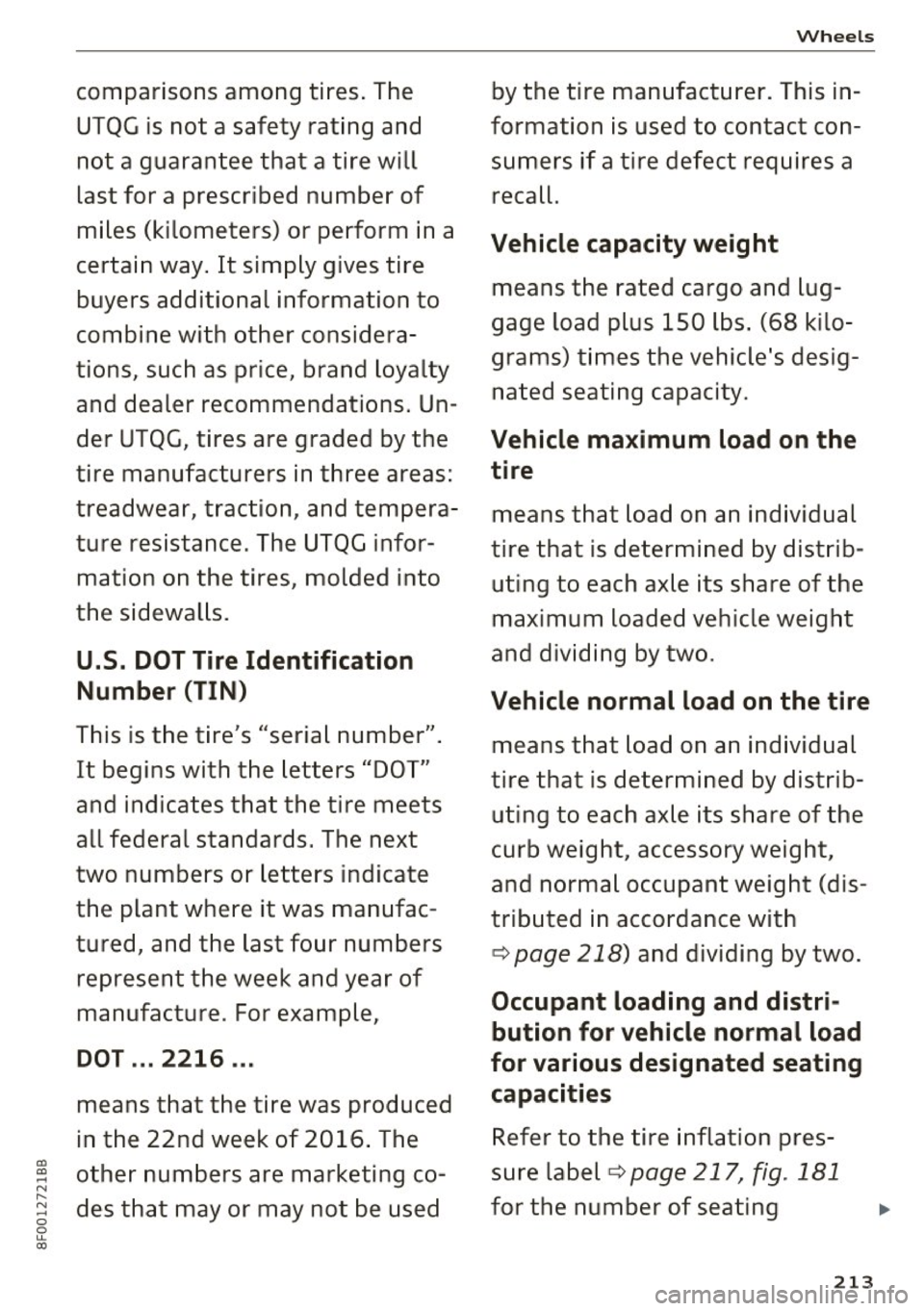
"' "' .... N ,.._ N .... 0
0
u. a:,
comparisons among tires. The
UTQG is not a safety rating and
not a guarantee that a tire will
last for a prescribed number of
miles (kilometers) or perform in a
certain way . It simply gives tire
buyers additional information to
combine with other considera
tions, such as price, brand loyalty and dealer recommendations. Un
der UTQG, tires are graded by the
tire manu facturers in three areas:
treadwear, traction, and tempera
ture res istance . The UTQG infor
mation on the tires, molded into
the sidewalls.
U.S. DOT Tire Identification
Number (TIN)
T his is the tire 's "seria l number" .
It beg ins with the letters "DO T"
and indicates that the tire meets
all federal s tandards. The next
two numbers o r letters indicate
the plant where it was manufac
tured , and the last four numbers
represent the week and year of
manufactu re . For example,
DOT ... 2216 ...
means that the tire was produced
in the 22nd week of 2016 . The
other numbers are marketing co des that may or may not be used
Wheels
by the tire man ufact urer. This in
formation is used to contact con
sumers if a tire defect requires a
recall.
Vehicle capacity weight
means the rated cargo and lug
gage load plus 150 lbs. (68 k ilo
grams) times the vehicle's desig
na ted seating capacity.
Vehicle maximum load on the
tire
means that load on an individual
tire that is determined by dist rib
uting to each ax le its share of the
maximum loaded veh icle weight
an d div id in g
by two.
Vehicle normal load on the tire
means that load on an individual
tire that is determined by distrib uting to each ax le its share of the
curb weight , accessory weight,
and normal occupant weight (dis
trib uted in acco rdance with
¢ page218) and dividing by two .
Occupant loading and distri
bution for vehicle normal load
for various designated seating
capacities
R efer to the t ire inflation pres
sure label
¢ page 217, fig.181
for the number of seating .,.
213
Page 216 of 266

Wheels
positions. Refer to the table
¢
page 218 for the number of
people that correspond to the ve
h icle normal load.
New tires or wheels
Audi recommends having all work
on tires or wheels performed by
an authorized Audi dealer or au
thor ized Audi Service Facility.
These facilit ies have the proper
knowledge and are equipped with
the required tools and replace ment parts.
.,. New tires do not yet have the
optimum gripping properties .
Drive carefully and at moderate
speeds for the first 350 miles
(500 km) with new tires.
1>-Use ti res of the same construc
tion , size (rolling circumference)
and as close to the same tread
pattern as possible on all four
wheels.
1>-0o not replace tires individually.
At least replace both tires on the
same axle at the same time.
1>-Audi recommends that you use
Audi Original Tires. If you would like to use different tires, please
note that the tires may perform
differently even if they are the
same size ¢
.&..
214
1>-Ifyou would like to equip your
vehicle with a tire/rim combina
tion that is different from what
was installed at the factory, con
sult with an authorized Audi
dealer or authorized Audi Service Facility before making a pur
chase ¢,&. .
The spare tire* is different from
the regular tires installed on the
vehicle -for example, if winter
tires or wide tires are installed -
so only use the spare tire* tempo
rarily in case of emergency and
drive carefully while it is in use. It
should be replaced with a regular
tire as soon as possible.
On
all wheel drive vehicles, all
four wheels must be equipped
with tires that are the same brand and have the same construction
and tread pattern so that the
drive system is not damaged by
different tire speeds . For this rea
son, in case of emergency , only
use a spare tire* that is the same
circumference as the regular
tires.
! WARNING
- Only use tire/rim combina
tions and suitable wheel bolts
that have been approved by .,.
Page 217 of 266
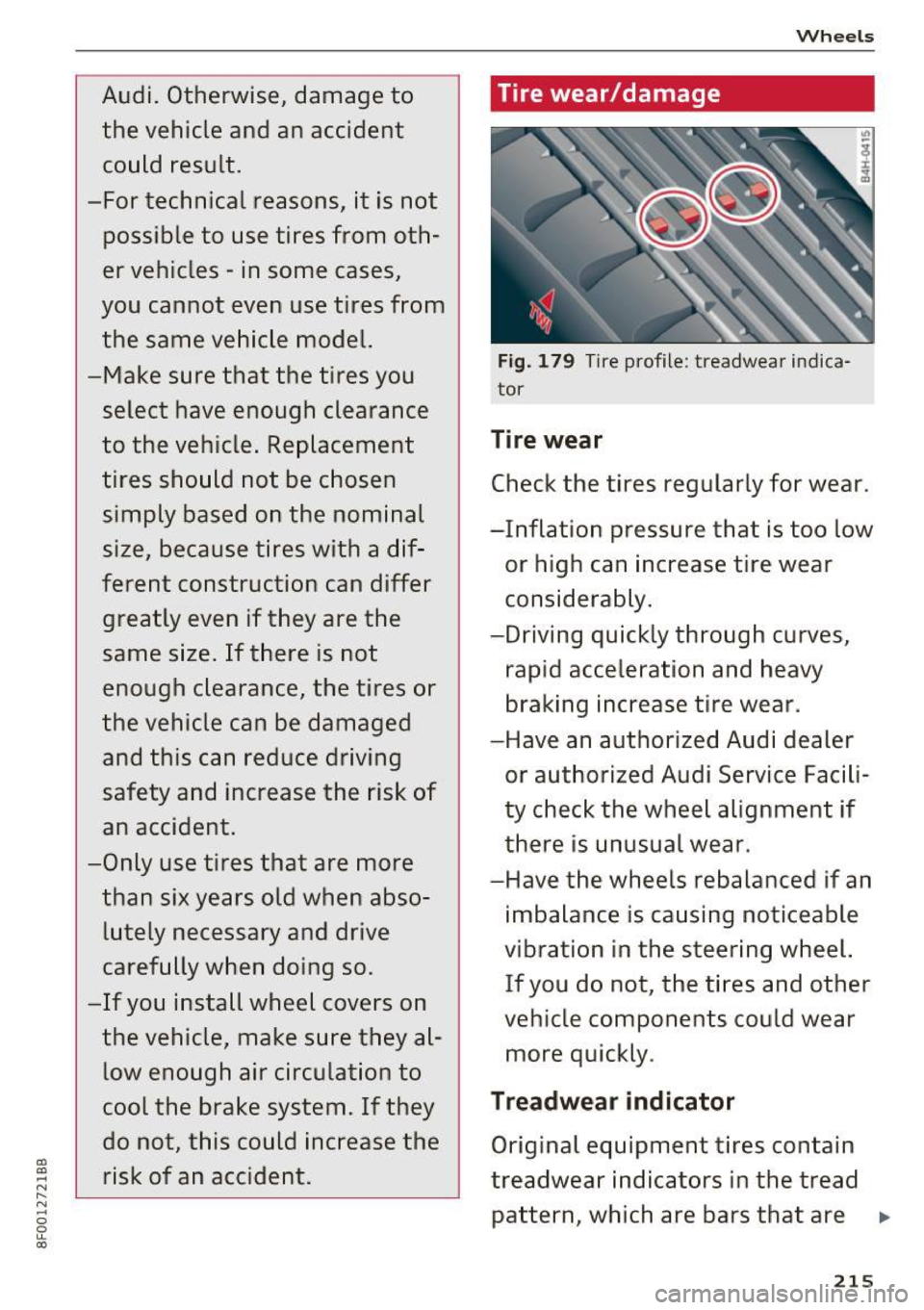
CX)
CX)
-N ,.... N
-0
0 l,L
CX)
Audi. Otherwise, damage to the vehicle and an accident
could result.
-For technical reasons, it is not
possible to use tires from oth
er vehicles -in some cases,
you cannot even use tires from the same vehicle model.
-Make sure that the tires you
select have enough clearance
to the vehicle. Replacement
tires should not be chosen
simply based on the nominal
size, because tires with a dif
ferent construction can differ
greatly even if they are the
same size. If there is not
enough clearance, the tires or
the vehicle can be damaged
and this can reduce driving
safety and increase the risk of
an accident.
-Only use tires that are more than six years old when absolutely necessary and drive
carefully when doing so.
-If you install wheel covers on
the vehicle, make sure they al low enough air circulation to
cool the brake system. If they
do not, this could increase the risk of an accident.
Wheels
Tire wear/damage
Fig. 179 Tire profi le: treadwear indica
tor
Tire wear
Check the tires regularly for wear.
-Inflation pressure that is too low or high can increase tire wear
considerably.
-Driving quickly through curves,
rapid acceleration and heavy
braking increase tire wear .
-Have an authorized Audi dealer
or authorized Audi Service Facili
ty check the wheel alignment if
there is unusual wear.
-Have the wheels rebalanced if an
imbalance is causing noticeable
vibration in the steering wheel. If you do not, the tires and other
vehicle components could wear
more quickly.
Treadwear indicator
Original equipment tires contain
treadwear indicators in the tread pattern, which are bars that are
215
...
Page 218 of 266
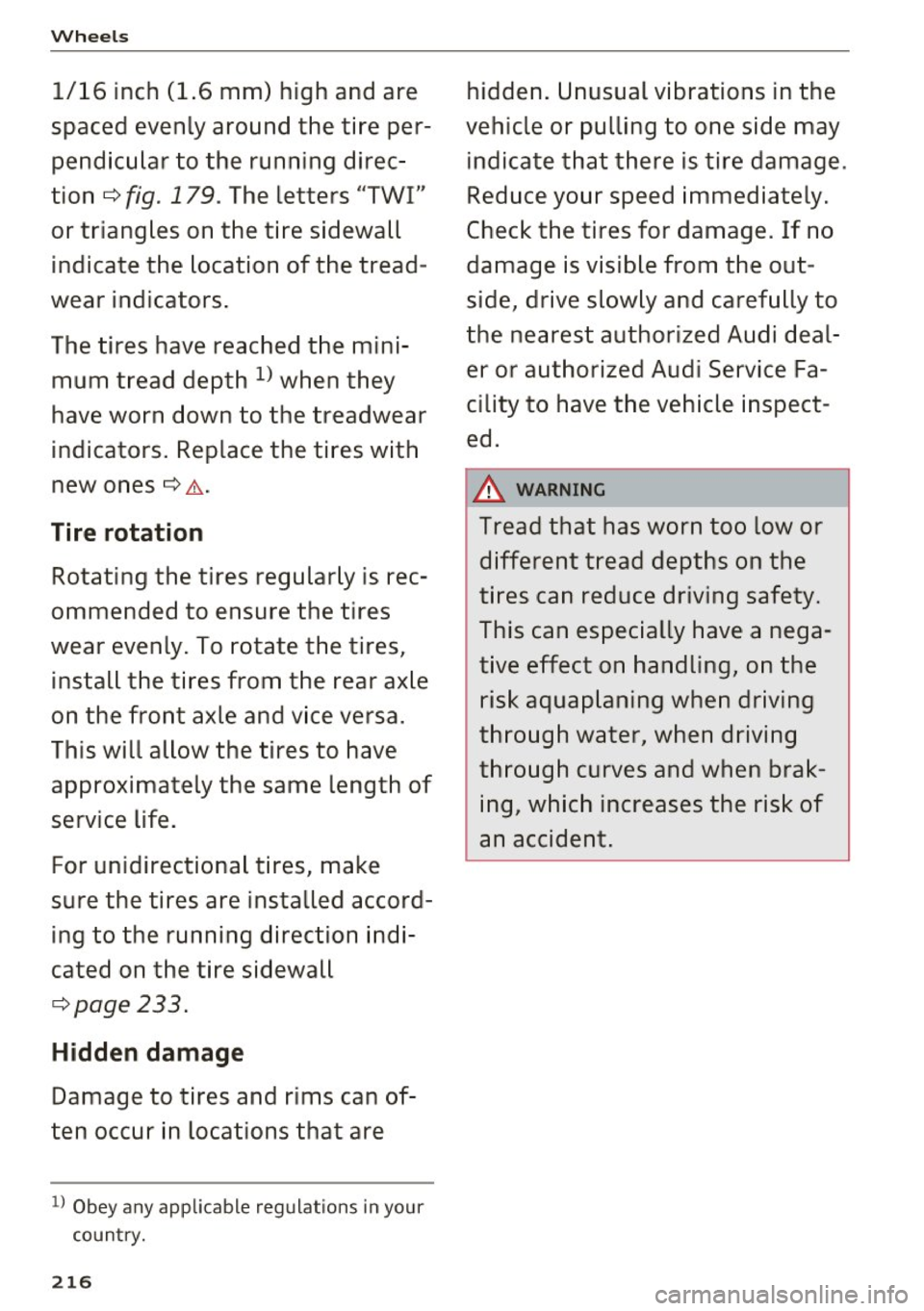
Wheels
1/16 inch (1.6 mm) high and are
spaced evenly around the tire per pendicular to the running direc
tion
¢fig . 179. The letters "TWI"
or triangles on the tire sidewall
indicate the location of the tread
wear indicators.
The tires have reached the mini
mum tread depth
l) when they
have worn down to the treadwear
indicators. Replace the tires with
new ones
¢ .&. .
Tire rotation
Rotating the tires regularly is rec
ommended to ensure the tires
wear evenly. To rotate the tires;
install the tires from the rear axle
on the front axle and vice versa.
This will allow the tires to have
approximately the same length of
service life.
For unidirectional tires, make
sure the tires are installed accord
ing to the running direction indi
cated on the tire sidewall
¢page 233.
Hidden damage
Damage to tires and rims can of
ten occur in locations that are
1> Obey any applicable regulations in your
country.
216
hidden. Unusual vibrations in the
vehicle or pulling to one side may indicate that there is tire damage .
Reduce your speed immediately.
Check the tires for damage. If no
damage is visible from the out
side, drive slowly and carefully to
the nearest authorized Audi deal
er or authorized Audi Service Fa
cility to have the vehicle inspect
ed.
_&. WARNING
Tread that has worn too low or different tread depths on the
tires can reduce driving safety.
This can especially have a nega
tive effect on handling, on the
risk aquaplaning when driving
through water, when driving
through curves and when brak ing, which increases the risk of
an accident.
Page 219 of 266
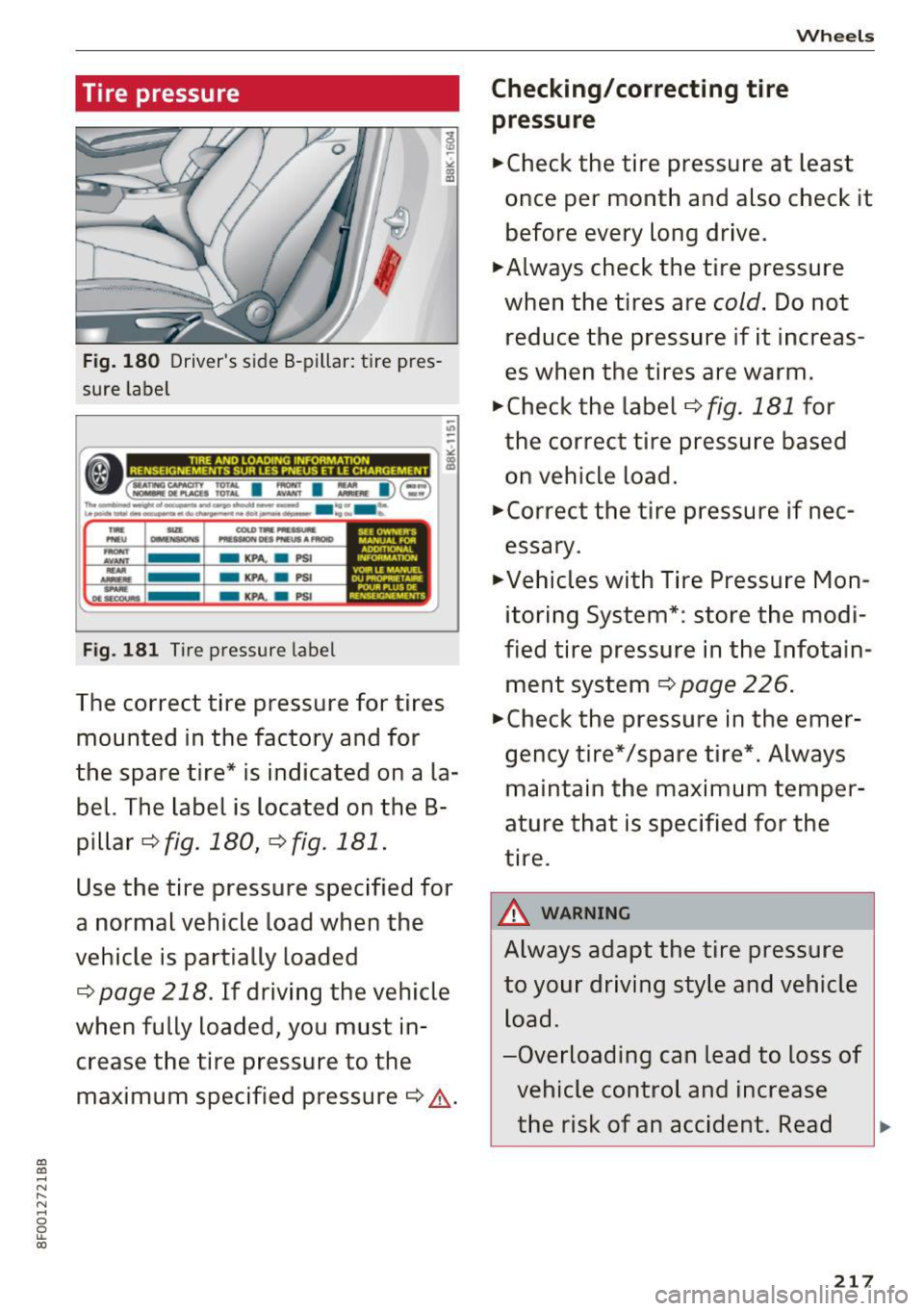
co
co
.... N
" N .... 0
0
u. 00
Tire pressure
Fig. 180 Driver 's side B -pillar : tire pres
sure label
"' -,,-------------------- ,.
9c:=:=. ~_:: I =:: I :.. I)@ :l! n. ...... _..,_ ... ___ ......, ____ .... _ ..
ui ............... ~-.... ~ .... .... ...
TR IIZI. 00lO TW.PMSIUl'll '""' ONiNSIC)N$ ,...._0UntlUSAN1011
-KPA. . PSI
Fig. 181 Tir e pressur e label
The correct tire pressure for tires
mounted in the factory and for
the spa re tire* is indicated on a la
bel. The label is located on the 8-
pillar ¢
fig. 180, ¢ fig. 181.
Use the tire press ure specified for
a normal vehicle load when the
vehicle is partially loaded
¢page 218. If driving the vehicle
when fully loaded, you must in crease the tire pressure to the
maximum specified pressure¢
A-
Checking/correcting tire
pressure
Wheels
.. Check the tire pressure at least
once per month and also check it before every long drive .
.. Always check the tire pressure
when the tires are
cold. Do not
reduce the pressure if it increas
es when the tires are warm.
.. Check the label¢
fig. 181 for
the correct tire pressure based on vehicle load.
..correct the tire pressure if nec
essary .
.. Vehicles with Tire Pressure Mon
itoring System*: store the modi
fied tire pressure in the Infotain
ment system ¢
page 226.
.. Check the pressure in the emer
gency tire* /spare t ire*. Always
maintain the maximum temper
ature that is specified for the
tire.
A WARNING
-
Always adapt the tire pressure
to your driving style and vehicle
load.
-Overloading can lead to loss of vehicle control and increase
the risk of an accident. Read
217
Page 220 of 266
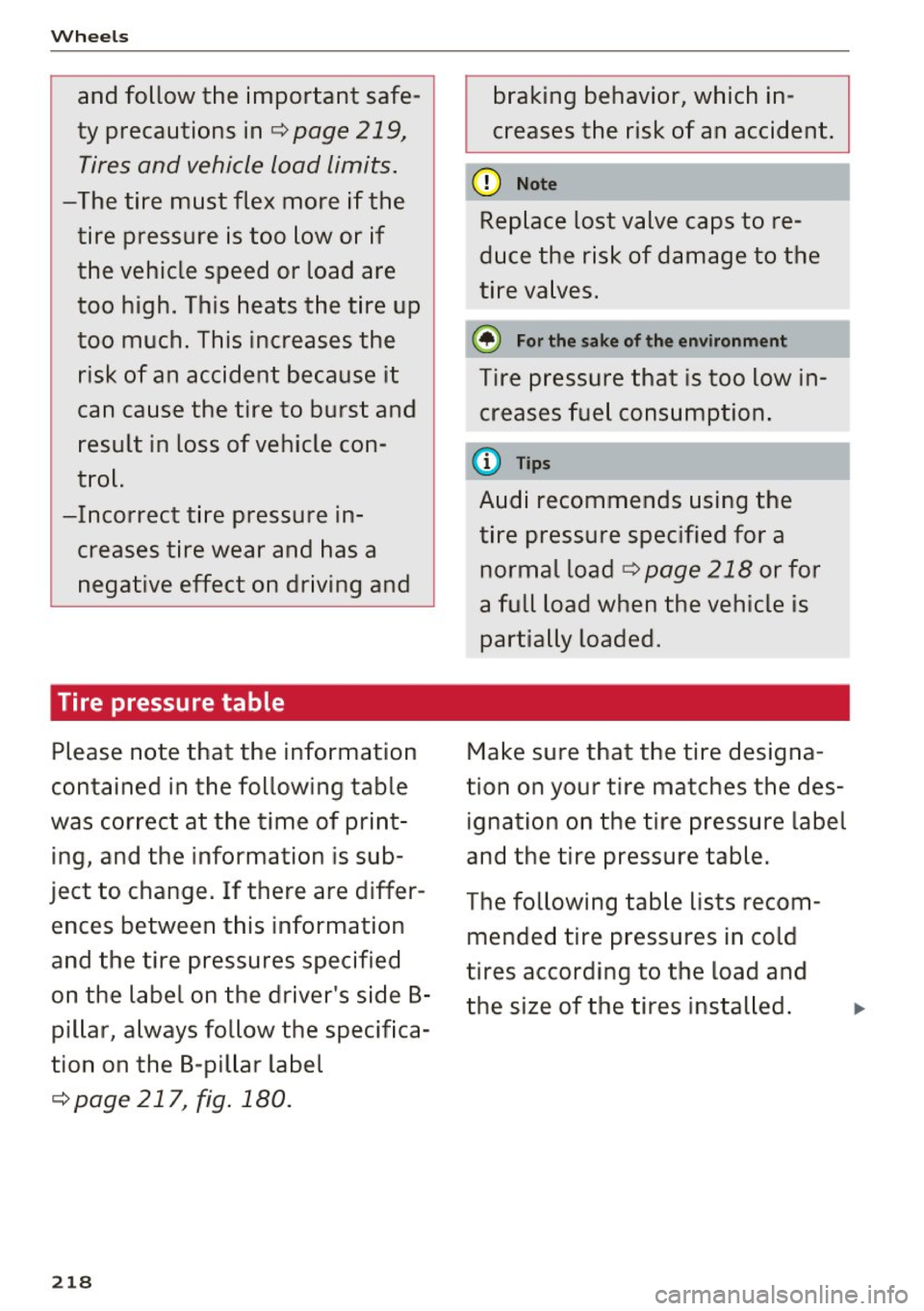
Wheels
and follow the important safe
ty precautions in
q page 219,
Tires and vehicle load limits.
-The tire must flex more if the
tire pressure is too low or if
the vehicle speed or load are
too high. This heats the tire up
too much. This increases the
risk of an accident because it
can cause the tire to burst and
result in loss of vehicle con
trol.
-Incorrect tire pressure in
creases tire wear and has a
negative effect on driving and
Tire pressure table
Please note that the information
contained in the following table
was correct at the time of print
ing, and the information is sub
ject to change. If there are differ
ences between this information
and the tire pressures specified
on the label on the driver's side 8- pillar, always follow the specifica
tion on the 8-pillar label
Q page217, fig.180.
218
braking behavior, which in
creases the risk of an accident.
(D Note
Replace lost valve caps to re
duce the risk of damage to the
tire valves.
@ For the sake of the environment
Tire pressure that is too low in
creases fuel consumption.
(D Tips
Audi recommends using the
tire pressure specified for a normal load
q page 218 or for
a full load when the vehicle is
partially loaded .
Make sure that the tire designa
tion on your tire matches the des ignation on the tire pressure label
and the tire pressure table.
The following table lists recom
mended tire pressures in cold
tires according to the load and the size of the tires installed.